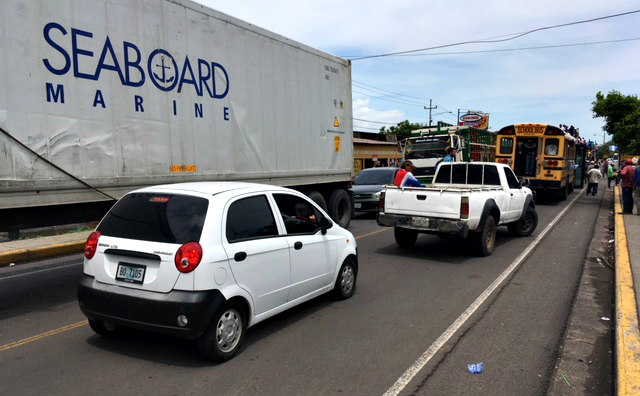Traveling to Managua used to be so easy, till a month ago. But since then road blocks have been raised as part of demonstrations against the current government. The protests started mid-April.
And how did the Government respond? The police shot at demonstrators and para-military groups were employed adding to the already existing unrest, pain and anger because of nearly 80 deaths, around 1000 injured, and many people missing or in prison. Therefore the call for change grows by the day.
These days you are either pro-Government or you belong to the people. The government uses a mix of the Nicaraguan flag (blue and white) and the party flag. The people only use the national flag. Needless to say that blue and white is becoming increasingly prominent as the President continues to lose support. Blue and white T-shirts with texts like “Nicaragua free” are flooding the market.
Before the protests started it was easy to hire a taxi to travel to Managua, but that is more problematic now. Fortunately I was still able to find a driver, through ‘friends of friends’, who was willing to take me to Managua to collect my Dutch friend Rob who had arrived two days previously.
30th of May
The 30th of May is Mothers’ Day in Nicaragua. This day was used for a demonstration in Managua by a movement of mothers who had lost sons or daughters in the past weeks. We anticipated that on this day it would be a bit easier to travel to Managua, and so it was.
On the way to Managua we only met two road blocks (see picture). Moreover, we drove in a convoy of trucks loaded with people from the rural areas who had already been travelling for hours to be present at the demonstration. On the way we saw many people lining the road to express their support. It is a period of agony and solidarity.
Rob was staying in a hostel at the edge of Managua so we could avoid the centre of town. The return journey took 5 hours, twice as long as usual, but not bad in the circumstances. Rob writes: “On our way to Juigalpa on the back of an open truck we came to three road blocks, which we got through quite quickly with the help of a middle man. At the edge of Juigalpa there was one more road block and we arrived at the community home at 5 pm, utterly soaked as the rainy season has started. (…) In the evening Astrid and I watched the news about the two demonstrations in Managua on Youtube as there is no television in the community home. The first demonstration was a protest against the Government, the second one was to support the mothers who had lost loved ones. The turn-out for the last demonstration was enormous. Apparently paramilitaries used force towards the end of demonstration”.
Sympathy
I know Rob from my student days. He was in Nicaragua before, in 1985. He was a member of one of the international brigades that came to Nicaragua to help with harvesting coffee when Nicaragua was at war with the ‘contras’. He had planned his current trip at the beginning of the year when Nicaragua was not yet in turmoil. Fortunately Rob’s aim is not to rediscover Nicaragua, an impossible task in the current situation, but solely to live with us in the community home for a month and contribute to it as a volunteer.
Rob writes about his first impressions: “31st May. I wake up tired after a wakeful night. I’m not used to hearing a lot of noise from the street. Breakfast is at 7am, and at 8am we have the meeting to discuss the day. At 9am we sing songs accompanied by tambourines. In the meantime doña Mayra mops the floors and Astrid does the shopping. Routine at the home is important. The residents need structure to function well. Everything here happens with a lot of attention, love and acceptance. They also need that”.
I hope we’ll hear more from Rob at the end of his stay.
Below are a few pictures of the road blocks. The man in the black shirt carries a ‘mortero’, an implement that produces a lot of noise and is for example used to announce that the barrier, usually lasting for about two hours, will be lifted for a while to allow traffic to pass. Soon after that, the road is blocked again.
PS:
- The human rights organisation of the OEA (= Organisation of American States) called CIDH in the meantime has been allowed to visit the country, and has experienced how much violence and terror is used by the police to knock protests on the head. The CIDH made 19 recommendations, well received by all, although in practice the Government has not started implementing the recommendations.
- Nicaragua even got onto the agenda of the European Parliament that condemned, with a large majority, the violations of human rights.



